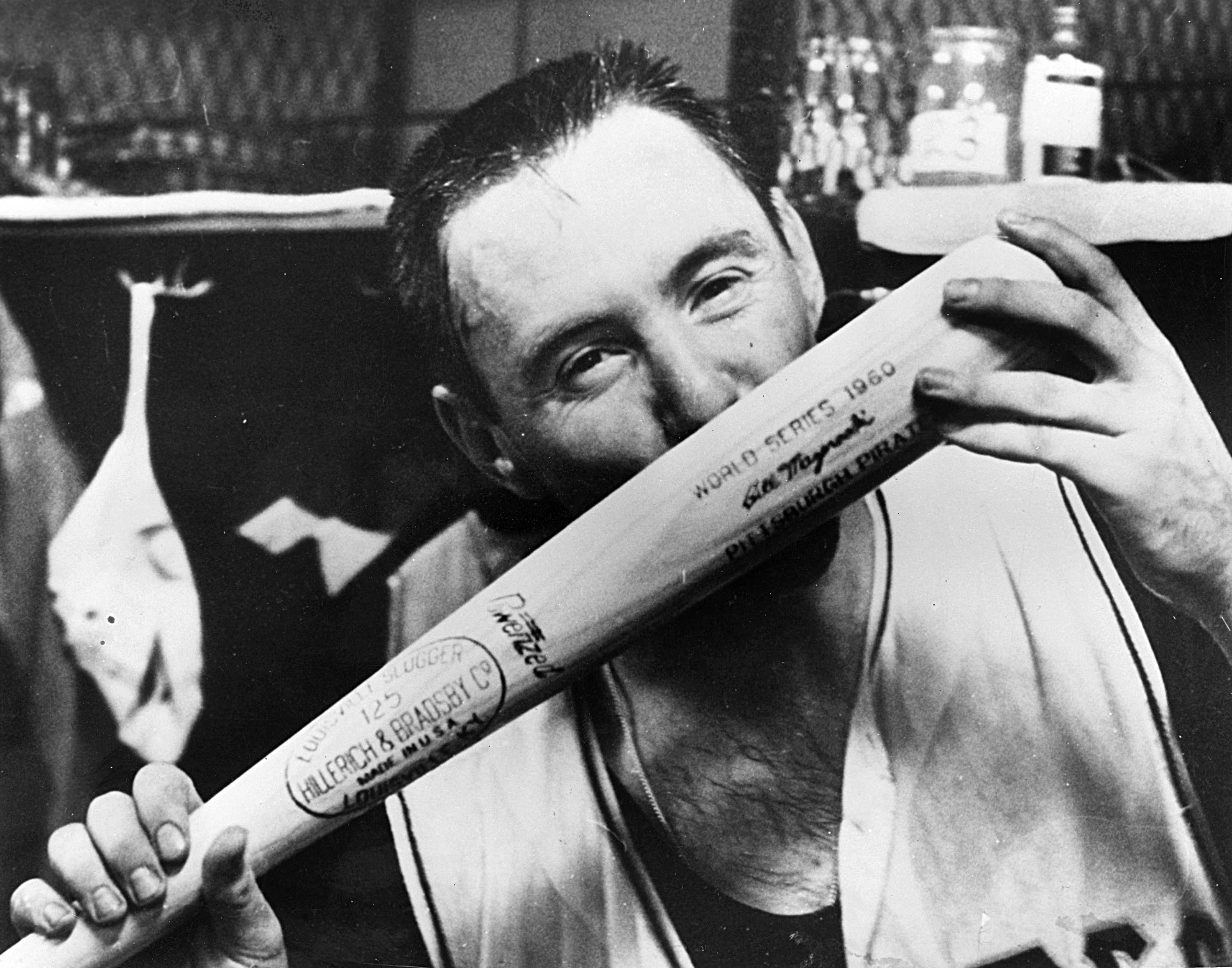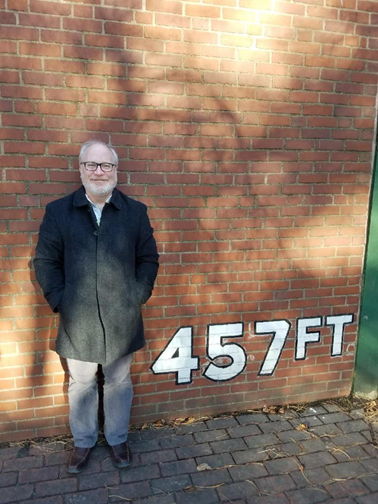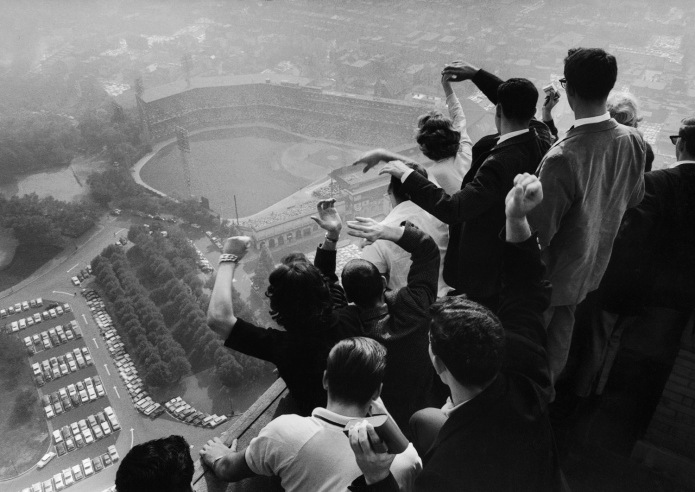The Annual Forbes Field Celebration: Pirates Fans Relive Mazeroski’s Moment
This article was written by Rich Puerzer
This article was published in The National Pastime: Steel City Stories (Pittsburgh, 2018)

On October 13, 1985, a Pittsburgh resident by the name of Saul Finkelstein decided to personally commemorate the 25th anniversary of the seventh game of the 1960 World Series. Finkelstein went to the corner of the University of Pittsburgh’s campus where Forbes Field was once located to listen to a tape recording of NBC’s broadcast of the game by Chuck Thompson and Jack Quinlan. On his way there, he bought a couple of hot dogs for his lunch from the Original Hot Dog Shop a few blocks away. Finkelstein sat down next to the flagpole that was once in deep center field, a few feet from the remnants of the center-field wall. He began the recording at 1:00 p.m.
The recording of the game concluded, just as the game and the 1960 World Series had 25 years earlier, at 3:36, when Bill Mazeroski hit one of the most famous home runs in baseball history.1 This solitary act by Saul Finkelstein of celebrating that game began a unique annual celebration, a tradition that would grow to include hundreds of people gathering annually at the vestiges of Forbes Field, listening to that World Series game, and celebrating one of the great moments in the history of baseball.
From 1985 to 1992, Finkelstein made this an annual event for himself. A quiet, wispy-haired, somewhat disheveled guy from Squirrel Hill, a nearby neighborhood, he obviously loved the Pirates. At a PiratesFest in January 1993, he told Jim O’Brien, who had just written the book Maz and the ’60 Bucs, about his annual pilgrimage. O’Brien was intrigued by the idea and spoke about it as a guest on a radio sports-talk show.2 Others read or heard his description and they too decided it would be a good idea to go celebrate Mazeroski’s home run and the 1960 World Series.
In October of that year, a number of others joined Finkelstein at the Forbes Field wall. After 1993, it became an annual event for many to go to the Forbes Field wall each October 13, listen, and celebrate. The event grew organically — there was no involvement on the part of the Pirates, no sponsorships, just baseball fans coming together each year to celebrate the 1960 World Series, the Pirates victory, Bill Mazeroski, and baseball.
Of course, the annual celebration would not take place if not for the event it recalls, the Pirates’ victory in the 1960 World Series, and specifically their dramatic win in Game Seven. The 1960 World Series was an unexpected gem. The Yankees, who finished the season with a record of 97–57, were World Series regulars, making their 10th appearance in 12 years. The Pirates, on the other hand, with a record of 95–59, were in their first World Series since 1927, when they were swept by the “Murderers’ Row” Yankees. The Yankees were managed by Casey Stengel and featured Mickey Mantle, Yogi Berra, Whitey Ford, Roger Maris, and Elston Howard. The Pirates were managed by Danny Murtaugh and their roster included Roberto Clemente, the double-play combination of Mazeroski and Dick Groat, and pitchers Vern Law and Roy Face. The Series was as tremendous as it was unusual. The Pirates won Game One 6–4, then got blown out in Games Two and Three by scores of 16–3 and 10–0. The Buccos came back and won the next two games, 3–2 and 5–2. Games Six and Seven were played in Forbes Field. The Yankees came back with another blowout win in Game Six, winning 12–0. Going into Game Seven, the Yankees had outscored the Pirates 46–17.
Game Seven of the 1960 World Series was one of the great games in the history of baseball. Not one batter struck out in the game, an oddity even in that era. The Pirates got out to a 2–0 lead in the first inning on a Rocky Nelson home run. They scored two more in the second and chased Yankees starter Bob Turley from the game. The Yankees tallied a run in the fifth inning on a Moose Skowron home run, and scored four more in the sixth, three of them on a home run by Yogi Berra. In the top of the eighth, the Yankees scored two more to make it, 7–4, but the Pirates answered with five runs in the bottom of the inning, including a now-underappreciated three-run homer by Hal Smith, to take a 9–7 lead. The Yankees answered back with two more runs in the top of the ninth inning to tie the game 9–9. The Pirates came to bat in the bottom of the ninth with Mazeroski leading off. At 3:36 p.m., with a 1–0 count, on a Ralph Terry slider, Bill Mazeroski, the Pirates’ 24-year old second baseman batting eighth in the order, hit arguably the most important home run in the history of baseball — or at least in the history of the Pirates. He pulled the ball to left-center field, over Berra’s head and over the ivy-covered brick wall. Mazeroski rounded the bases, batting helmet in hand, to the roar of the crowd. The jubilant fans at Forbes Field and throughout Pittsburgh were delighted.
The aftermath, like the World Series itself, was unique and substantial. The Series MVP was Bobby Richardson of the Yankees, the only player on a losing team ever to win it. Mantle wept following the seventh game, and later said it was the only loss that affected him that much. Stengel was fired as manager of the Yankees and said, “I’ll never make the mistake of being 70 again.”3 In 1961, the Yankees, now managed by Ralph Houk and led by Maris, had a tremendous season, winning 109 games and the World Series. The Pirates, on the other hand, fell to sixth place and did not win another pennant until 1971.

SABR member Rich Puerzer stands at the site of old Forbes Field in Pittsburgh, where baseball fans gather every October 13 to watch a broadcast of Game Seven of the 1960 World Series. (COURTESY OF THE AUTHOR)
Among the most important reasons the annual commemoration occurs is that one can still make the pilgrimage to the former location of Forbes Field and see parts of the great old ballpark, which remain almost as sacred grounds today. While the location of most former ballparks is evinced by little more than a historical marker, a portion of Forbes Field’s brick center-field wall still stands, alongside the base of the original flagpole. Home plate itself still remains near its original location, encased in glass in the floor of an academic building on the University of Pittsburgh campus. These relics provide visitors with the ability to see, touch, and celebrate the great old stadium.
Forbes Field, to some, was the perfect ballpark. Built in 1909 by visionary and influential Pirates owner Barney Dreyfuss, it was among the first steel and concrete stadia. It was located in the then-affluent Oakland section of Pittsburgh, bordering the University of Pittsburgh, Carnegie Tech (later Carnegie Mellon University), and Schenley Park. The Cathedral of Learning, the University of Pittsburgh’s iconic 42-story Gothic building, was just a few blocks away and provided a location for some Pirates fans to watch games.Like most fields in that era, Forbes was asymmetrical, and it had a huge, triples-inducing outfield. In addition to being the home of the Pirates, it was also the location of a number of prominent events. It was at times home for the Homestead Grays and Pittsburgh Crawfords of the Negro Leagues. The Pittsburgh Steelers played football at Forbes Field, as did all of Pittsburgh’s college football teams. Several boxing title fights and political rallies took place there, and the 1951 version of the movie Angels in the Outfield was filmed there. No no-hitters were ever pitched at Forbes Field, but Babe Ruth hit his last three home runs there. Rickwood Field in Birmingham, Alabama, which was built in 1910 and is still standing today, was modeled after Forbes Field.
By the late 1960s, the park was showing its age. It had very little parking and was not easy to get to — the same issues that led to the demise and replacement of many other ballparks in the era. It was decided that Forbes Field would be replaced with the multi-use Three Rivers Stadium, to be built downtown. The final games at Forbes Field, a doubleheader, were played against the Cubs on June 28, 1970. Two years later, the stadium was torn down to make way for several University of Pittsburgh buildings.4 Home plate is now located in Posvar Hall. Some of the land on which Forbes Field sat remained the property of the city of Pittsburgh, and the city presciently allowed segments of the outfield wall to remain. The brick wall was built in 1946, when wood walls were replaced. The city also added a small baseball field adjacent to it, appropriately named Mazeroski Field.
In his book Baseball as a Road to God, author and New York University President John Sexton states: “When Pirates fans congregate at the remaining piece of the Forbes Field wall, they see the monument as much more than slabs of brick, and they arouse the deeper perception that religious man has brought to many sacred spaces through the ages.”5 If these relics of the field were not standing today, it is unlikely that the annual celebration of 1960 would exist. Mazeroski serves as something of a patron saint for the annual celebration. Not only was he an unexpected hero of the 1960 World Series, he had a long, blue-collar career with which many Pittsburghers could readily identify. Mazeroski was born relatively close to Pittsburgh in Wheeling, West Virginia, and grew up just on the Ohio side of the border. He is considered by many to have been the greatest fielding second baseman of all time, winning eight Gold Glove Awards and turning more double plays in his career than any other second baseman in the history of the game. Mazeroski was named to 10 All-Star teams during his 17-year career, all of which he spent with the Pirates. He retired following the 1972 season and was inducted into the National Baseball Hall of Fame in 2001. On September 5, 2010, his 74th birthday, the Pirates unveiled a 12-foot-tall statue of Mazeroski outside of PNC Park, depicting him running around the bases after hitting his momentous home run.6
The annual celebration continued on through the 1990s, with attendance steadily growing each year. Mazeroski made an appearance at the event in 2000, celebrating the 40th anniversary with about 400 other attendees. Steve Blass, who was signed out of high school by the Pirates in 1960 but did not debut with the team until 1964, has attended several times. Another former player who has attended more than once is Frank Thomas, who was one of the players traded by the Pirates to the Reds in 1959 for Harvey Haddix, Don Hoak, and Smokey Burgess — a move that helped the Pirates a great deal in 1960. Other former Pirates have also attended over the years.

Fans gather to watch Game Seven of the 1960 World Series at the top of the Cathedral of Learning on the University of Pittsburgh campus on October 13, 1960. (NATIONAL BASEBALL HALL OF FAME LIBRARY)
Saul Finkelstein passed away in 2004. But by this time there were others who had followed in his footsteps and attended each year. In 2006, some of these regulars formed a group known as the Game 7 Gang, dedicated to continuing the annual celebration. Herb Soltman, de facto leader of the Game 7 Gang, was at the game in 1960. Soltman has served as the master of ceremonies for the event for several years. George Skornickel, another Game 7 Gang member, has made the celebration a multi-generational family celebration. His daughter has joined him at the celebration each year for decades, and his granddaughter has joined the two of them every year of her young life.7 For the members of the Game 7 Gang and all of the other attendees, the event reflects what is best and what is to love about baseball.
Each year, the crowd acts as if they are not just listening to the game, but playing the part of the fans who were there in 1960. They sing the national anthem, applaud as the game goes along, lament when the Yankees score, cheer when the Pirates do, sing “Take Me Out to the Ballgame,” worry as the game goes to the ninth inning, and, of course, cheer when Mazeroski hits his home run. One rule that is followed by all attendees is that no one celebrates with high fives, as the gesture was not in use in 1960.
In 2010, the 50th anniversary was celebrated in a special way. The Pirates organization joined in helping to organize the event and invited every living member of the 1960 team to celebrate at the wall. Players who attended included Groat, Smith, Law, Face, Bill Virdon, Bob Friend, Joe Christopher, George Witt, Joe Gibbon, Bob Oldis, and of course Mazeroski. Vera Clemente, Roberto’s widow, and their son Luis also attended. They were joined by more than 1,000 fans who came to listen to the game and celebrate. Since 2010, the celebration has returned to normal. In 2016, no former players were among the roughly 75 people who attended.
Every October 13, in a corner of the baseball world in Pittsburgh, you will find a special celebration of the history, love, and joy of baseball. Each year, a group of baseball fans, and this event itself, are able to turn back the clock, if but for a few hours, and celebrate a great baseball game. One can only hope that this celebration of Bill Mazeroski’s home run, Forbes Field, the Pirates, and victory in the 1960 World Series continues on as long as people are playing, and loving, baseball.
RICHARD J. PUERZER is an associate professor and chairperson of the Department of Engineering at Hofstra University. He has contributed to several SABR books, including “Mustaches and Mayhem: The Oakland Athletics: 1972-1974” (2015), “When Pops Led the Family: The 1979 Pittsburgh Pirates” (2016), and “Bittersweet Goodbye: The Black Barons, The Grays, and the 1948 Negro League World Series” (2017). His writings on baseball have also appeared in: “NINE: A Journal of Baseball History and Culture,” “Black Ball,” “The National Pastime,” “The Cooperstown Symposium on Baseball and American Culture proceedings,” “Zisk,” and “Spitball.”
Sources
David Finoli and Tom Aikens, Forbes Field (Charleston, SC: Arcadia Publishing, 2013).
Pittsburgh Pirates, Forbes Field 60th Birthday, 1909–1969: Pittsburgh Pirates Picture Album (Pittsburgh: Pittsburgh Pirates, 1969).
Len Martin and Dan Bonk, Forbes Field: Build It Yourself (Oakmont, PA: Point Four, 1995).
Jim O’Brien, Maz and the ’60 Bucs: When Pittsburgh and Its Pirates Went All the Way (Pittsburgh: James P. O’Brien Publishing, 1993).
Baseball-Reference.com, https://www.baseball-reference.com/.
Notes
1 Jim O’Brien, “Relive the Pirates’ Wonderful World Series Victory Over the New York Yankees in 1960,” Valley Mirror, October 9, 2014; O’Brien, “Saul at the Wall,” in Forbes Field: Essays and Memories of the Pirates’ Historic Ballpark, 1909–1971, ed. David Cicotello and Angelo J. Louisa (Jefferson, NC: McFarland, 2007), 150-154.
2 O’Brien, phone interview, May 9, 2017.
3 Marty Appel, Casey Stengel: Baseball’s Greatest Character (New York: Doubleday, 2017), 277.
4 The School of Law, School of Business, and Posvar Hall.
5 John Sexton, Baseball as a Road to God (New York: Gotham Books, 2013), 27.
6 Mazeroski’s statue joined statues of all-time great Pirates players Honus Wagner, Roberto Clemente, and Willie Stargell.
7 George Skornickel, email correspondence with author, May 24, 2017.


